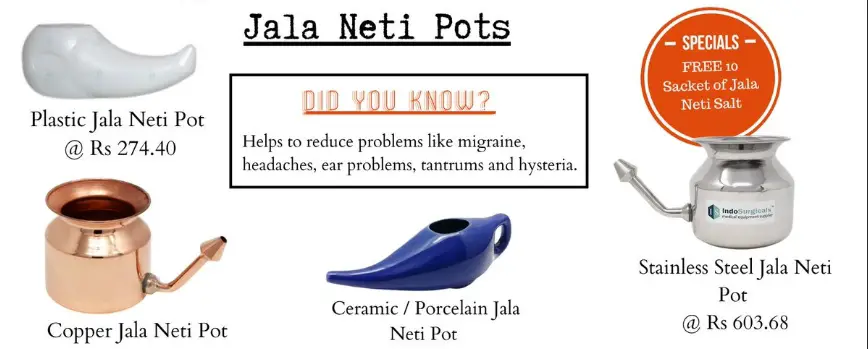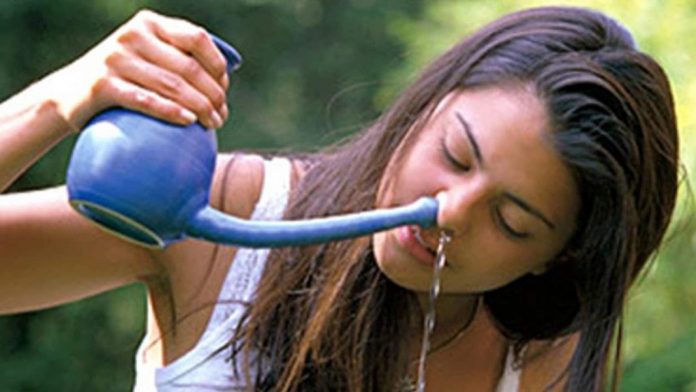Jala Neti The act of purification is highly valued in the yogic way of life. Deep organ cleansing is thought to be necessary to remove illnesses and toxins from our bodies and prepare our systems for the benefits of yoga.
These cleansing techniques of yoga are called the Kriyas. They form an important section called the Shatkarmas in the Hatha Yoga Pradipika, a classical treatise of Hatha Yoga.
In this post, we’ll go over the steps for Jal Neti, a well-known yoga kriya for clearing nasal passages.
What is Jala Neti?
Jal Neti is one of the purification kriyas of yoga which is dedicated to the cleansing of the nasal passage. There are other types of the net as well which are used for nasal cleansing.
Jal Neti, commonly known as nasal irrigation, is a phrase that literally translates as “water cleansing.” In this kriya, water is utilized to relieve nasal congestion, enabling healthy breathing.
Asthma and other respiratory disorders like sinusitis and migraines are all linked to an unhealthy or improperly functioning nose passage. By cleansing the nasal tract, Jala Neti provides relief from all of these issues.
Besides draining out all the impurities clogging your nasal passage, Jal Neti is helpful for clairvoyance and effectively does pranayama practice. Doing this kriya is useful for you if you reside in a place affected by Air Pollution or is congested.
When the nose is free from any blockages or discomfort, you can better benefit from pranayamas. Thus, the process of Jal Neti is periodically done to clean the sinuses and maintain nasal hygiene.
Benefits of Jala Neti
The benefits of the Jala Neti procedure are numerous. It is thought of as a therapeutic practice that keeps the nasal canal healthy so that a person may breathe more easily and prevent any nose issues.
Here are some of the most significant advantages of Jala Neti:
1. It Treats the Sinusitis
Sinusitis affects a relatively large population, including youngsters. It has been shown that performing Jal Neti often is helpful for relieving sinusitis problems. It clears the nasal passageway of allergens and irritants, which soothes sinusitis.
Sinusitis affects a relatively large population, including youngsters. It has been shown that performing Jal Neti often is helpful for relieving sinusitis problems. It clears the nasal passageway of allergens and irritants, which soothes sinusitis.
In an experiment conducted on patients with Chronic Rhinosinusitis, Jala Neti reduced the symptoms like the need to blow the nose, running nose, postnasal discharge, and sneezing to a great extent [efn_note] Effect Of Saline Nasal Irrigation (Jala Neti) In Chronic Rhino Sinusitis http://www.ijiras.com/2018/Vol_5-Issue_7/paper_54.pdf [/efn_note].
In another review study Health and Therapeutic Benefits of Shatkarma [efn_note] Health and therapeutic benefits of Shatkarma: A narrative review of scientific studies https://www.sciencedirect.com/science/article/pii/S0975947620301297 [/efn_note], it is found that after a period of regular Jal Neti practice, the symptoms and the need for external medication were significantly reduced. Nasal cleansing, Neti was particularly found beneficial in managing rhinosinusitis in age groups ranging from children to adults.
2. It Helps Breathe Freely
All of the infections and unhealthy debris must be removed from the nasal canal using a Jala Neti. One is then able to breathe normally and freely as a result.
Jala Neti has been shown in studies to help dissolve internal mucus buildup and clear the nasal cavity, allowing for easy, deep breathing.
Regularly performing Jal Neti serves as a defense mechanism against different upper respiratory infections as well as nasal infections.
3. It Treats Headaches and Hypertension
By reducing excessive heat, Jala Neti provides cooling and calming advantages to the brain.
It aids in the treatment of illnesses of the brain such as migraine, hypertension, and headaches. Epilepsy, tantrums, hysteria, sadness, and general mental stress have all been successfully treated by Kal Neti.
4. It Helps Improve the Nasal Functions
According to Western medicine, the danger triangle of the face is centered on the nose. Given that breathing is directly connected to this tube, any infection in the region around the nose can be extremely dangerous.
Jala Neti works on the nose’s surrounding areas to clear them of all pollutants. It leads to an improvement in nasal health and nasal and respiratory function.
5. It Improves the Vision
The Jala Neti also has positive effects on the optic nerve. In a 2010 study [efn_note] Effects of Jala Neti on Optic Nerve Conduction Velocity https://www.researchgate.net/profile/Kamakhya-Kumar/publication/215447507_Effect_of_Jala_Neti_on_Optic_Nerve [/efn_note], it was demonstrated that Jal Neti can improve optic nerve conduction.
This indicates that Jala Neti cleans the eye and its post-retinal optic nerves in addition to the fused matter of the ENT system.
The autonomic nervous system is stimulated by the stimulation of the optic nerves, which leads to improved optic nerve functioning and clearer eyesight.
6. It Treats Major ENT Diseases
Jala Neti has shown to be useful not just for nose issues but also for throat and ear conditions.
In 2018, when the Immediate Effects of Jal Neti were observed by the Yoga and Naturopathy Medical College Chennai [efn_note] Immediate effect of Jala Neti (Nasal Irrigation) on nasal peak inspiratory flow on healthy volunteers http://repository-tnmgrmu.ac.in/10176/ [/efn_note], it was found that the Jal Neti maintains healthy secretory and drainage mechanisms of the entire ear, nose, and throat area.
The research also revealed that Jala Neti is effective in treating tonsillitis, hay fever, allergic rhinitis, colds, and coughs.
6. It Treats Major ENT Diseases
Jala Neti has proven effective on not just nasal troubles but also diseases related to the ears and throat.
In 2018, when the Immediate Effects of Jal Neti were observed by the Yoga and Naturopathy Medical College Chennai [efn_note] Immediate effect of Jala Neti (Nasal Irrigation) on nasal peak inspiratory flow on healthy volunteers http://repository-tnmgrmu.ac.in/10176/ [/efn_note], it was found that the Jal Neti maintains healthy secretory and drainage mechanisms of the entire ear, nose, and throat area.
The study also found that Jala Neti helps remove colds and coughs, allergic rhinitis, hay fever, and tonsillitis.
7. It Stimulates the Olfactory Nerves
Jala Neti completely cleans and purifies the nose tube, which is why it is seen to enhance the olfactory nerves’ performance.
The interaction between smell, taste, and digestive processes is benefited by Neti since it aids in regaining the sense of smell that has been lost.
The procedure of Jal Neti

Before beginning the Jala Neti practice, there are a few things you need to do.
Jala Neti requires a neti pot, a dash of salt, and lukewarm water as basic ingredients.
Here is the detailed process;
1. Take a mug of lukewarm water
In Jala Neti, cleansing occurs using water as the medium. To promote proper cleansing and prevent any impurity buildup of water in the nasal cavity, use pure drinking or distilled water.
Additionally, this water is warmed at room temperature because warm water often has a lower absorption rate by nasal muscles than cold water. This prevents water from building up in the nasal passages.
Pour a small amount of water over your palm to determine whether the temperature is appropriate for Neti. You can determine whether the water is warm enough to pour into the nose in this way.
Water should ideally be the same temperature as your tears.
2. Mix salt into it
By adding salt to the saline water used in Jala Neti, the nasal cavity muscles are further less able to absorb the entire solution. Jala Neti is best performed with finer “sea salt,” which dissolves more quickly in the water and contains no other minerals.
For Jala Neti, which was traditionally made with sea salt, one can substitute regular table salt if “sea salt” is not readily accessible.
It is necessary to make the solution isotonic, or tonic, like human blood.
To make your own saline mixture for Jala Neti at home;
Take one pint (equivalent to 16 ounces or 500 ml) of warm water.
For the nose, a solution with a salinity of 1 teaspoon/500 ml is typically regarded as optimum (you can use 1/2 or even 1/4 teaspoon of salt).
Pour the appropriately combined salt and water into the neti pot.
3. Pour saline water into the neti pot
A neti pot is a device resembling a teapot; it is typically small and has a long spout on one side. Its shape makes it easy to insert into the nostrils without obstructing airflow.
After thoroughly mixing the saline solution, the Jala Neti technique calls for pouring it into the neti pot. In most cases, Neti pots have a 500 ml (about 1 pint) capacity, therefore this volume of water is sufficient to clear nasal passages.
Using a Neti pot is simple, place the long spout on one side to insert it in each nostril one by one.
How to Do Jala Neti?

- Add a half teaspoon of salt into the Neti pot filled with sterile lukewarm water.
- Stand with your legs apart and hold the pot in your right hand.
- Now by slightly tilting your head towards the left, insert the nozzle of the Neti pot in your right nostril.
- Start pouring water in the right nostril slowly by breathing normally through your mouth.
- Allow the flow till the Neti pot is empty.
- Repeat the same procedure from your left nostril.

Tip:
Open your lips during the entire neti pot procedure so you may take slow, gentle breaths through it. While using the neti pot, refrain from using your nose to breathe.
Use a container on the ground to “not spread” the water draining out of your nose if you are not performing Jala Neti on the sink.
Open your lips during the entire neti pot procedure so you may take slow, gentle breaths through it. While using the neti pot, refrain from using your nose to breathe.
Use a container on the ground to “not spread” the water draining out of your nose if you are not performing Jala Neti on the sink.
Drying of the nostrils
To avoid getting a cold, a sinus infection, or an ear infection, both nostrils must be thoroughly dried after the water has been drained from them. If the nose doesn’t dry up, it could also cause a slight headache.
- Stand upright and bend forwards from the waist
- Keep your head upside down with the nose pointing towards the floor, In this way, any leftover water is drained from the nose
- Point the nose towards the knees.
- For about 10 times, inhale from the mouth and exhale from the nose in each position.
- The water residues may run down.
- Stand up and breathe rapidly through the nostrils for about 10 consecutive breaths. Sniff in and out.
- Focus on the exhalation.
- Use one finger to close off the right nostril and breathe through the left and vice versa.
- Breathe through both nostrils 10 times.
Repeat until the nose gets properly dried.
3 Stages of Jala Neti
Depending on the practitioner level, there are three levels to the Jala Neti practice. These are the three phases of Jala Neti.
Stage 1 – Simple Jala Neti
This is the easiest, most fundamental stage of Jala Neti. Water is seen flowing from one nostril to the other in this (what we have discussed in the above procedure).
Stage 2 – Vyutkarma Kapalbhati
This is an advanced level of Simple Jala Neti, therefore novices may need thorough instruction from a teacher.
It is sometimes referred to as “Sinus Bellowing” or “Vyutkarma Kapalbhati,” and it is more successful at treating the posterior sinuses than plain Jala Neti.
1. Permit the water to freely flow from one nostril to the other (Like simple Jala Neti).
2. Gently inhale the water while gently inhaling it backward.
3. hurled that water back out of his mouth.
4. Do not ingest any water.
Another portion of this phase involves inhaling water separately via each nostril and then spitting it out of the mouth. The nose is then given time to dry.
Stage 3 – Sheetkarma Kapalbhati

The third stage of simple Jala Neti is called Sheetkarma Kapalbhati, which is a level that is more sophisticated. It is challenging and initially awkward to perform.
This involves blowing water out of the nose after taking it from the mouth. It is more advantageous and efficient.
When to Practice Jala Neti?
Three to four mornings a week, you can perform Jal Neti. However, everyday practice should only be done in the beginning for the sake of learning; as one becomes more accustomed to it, it should only be done a few days a week.
The night before practicing, some practitioners also apply cow ghee (butter) to their nostrils. It facilitates uninterrupted water passage by enhancing the flow of water from the nostrils.
Jal Neti can be used every day by those who frequently suffer from colds and coughs to lessen their symptoms and reap the greatest advantages.
Precautions and contraindications
If the practitioner recently had ear or nose surgery, they shouldn’t perform a Kal Neeti. If a person has a bleeding nose as a result of any nasal issue, Jal Neti is not indicated.
Jala Neti should also only be performed for the first time under the supervision of a qualified yoga teacher.
After performing Jala Neti, practitioners should always make sure their nostrils are fully dry. Headaches may result from water droplets that are still present in the nasal canal.
When drying their noses, people with high blood pressure should use caution. There is a potential that they will feel lightheaded if the drying process is done vigorously.
1. If water runs onto the face

Water may spill into the face while doing Jal Neti because of flaws in the pot or its location. Taking precautions and moving slowly through the procedures will help to avoid this issue.
It can also be avoided by maintaining the proper angle between the pot and the head.
2. If water goes to the back of the throat
It often occurs due to nervousness and hurry. To avoid this, perform the steps slowly, and gently with a proper tilt of the head. Take care of the position of the pot.
3. Avoid blockage of water
Water may spill into the face while doing Jal Neti because of flaws in the pot or its location. Taking precautions and moving slowly through the procedures will help to avoid this issue.
It can also be avoided by maintaining the proper angle between the pot and the head.
4. Nasal irritation
Pollutants present in the water and the contaminated pot cause stinging in the nose. Rinse the pot properly.
To prevent excessive nasal irritation, use pure water and the appropriate proportion of salt.
5. Popping in the ears
When water flows through the nostrils, the Eustachian tube releases pressure, which can cause ear discomfort. There is no reason to be alarmed. It quickly passes.
What are the Side-Effects of Jal Neti?
Sneezing or itchiness are frequent side effects of a Jal Neti. They do, however, get better as you go along or as you get more comfortable with the activity.
After performing Neti, one immediately feels a scorching feeling. It could happen if the solution is incorrect or if the water in the pot is too hot.
As a result of Jal Neti, some practitioners also experience a minor nosebleed. It might take place if the water in the Neti pot is too hot. If someone has a propensity for nosebleeds, it may also happen to them.
Jal Neti is an advised practice that should be done initially under supervision to prevent these unwanted effects.
Final Thoughts
For a very long time, cleansing methods like Jal Neti have been recommended and used as medicinal practices. They are referred to in Hatha Yoga Pradeepika as purificatory movements to wash away the pointless and get our system ready for the essentials.
The karmas that Hatha Yoga discusses, however, have a set of rules that must be followed. With a skilled supervisor, the procedures can be practiced more effectively. Once you have learned them, you may put them into practice on your own and reap a variety of advantages.
So, if you’re going to begin getting ready for the cleansing procedures, consider what is essential and what is crucial. Be knowledgeable about all elements of it. Start anything the right way if you want it to go well!





















